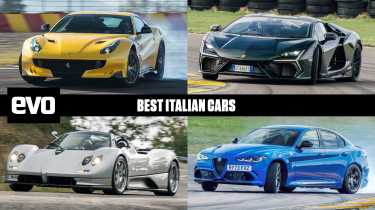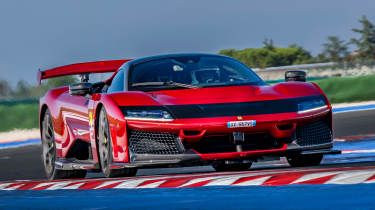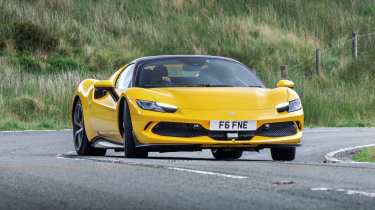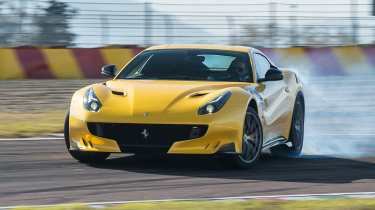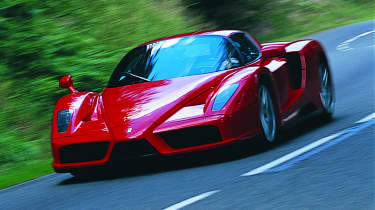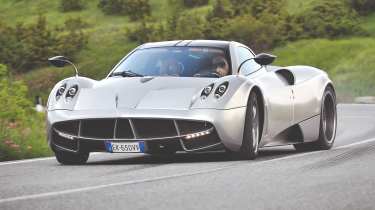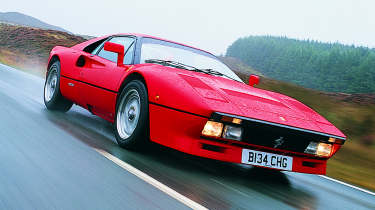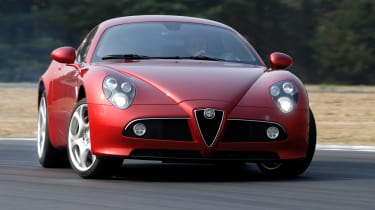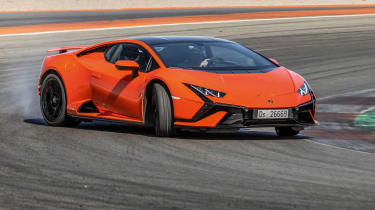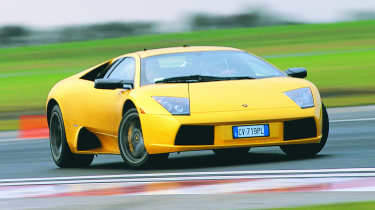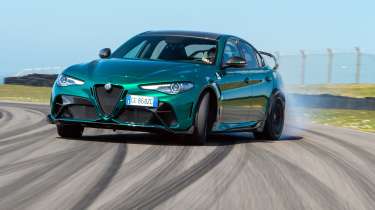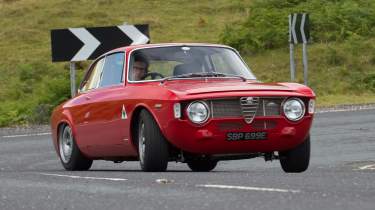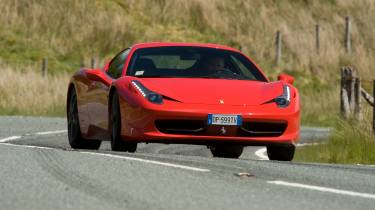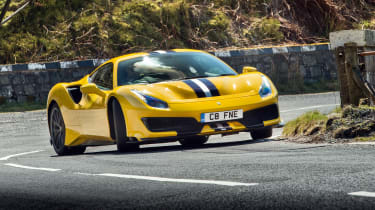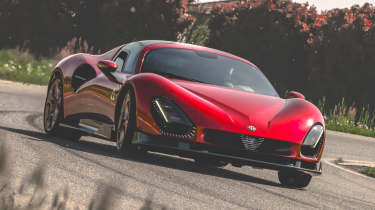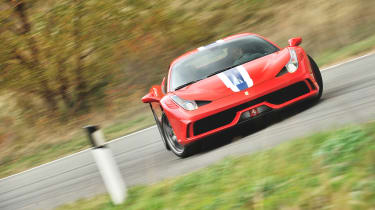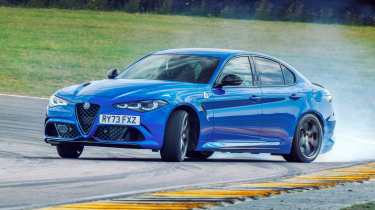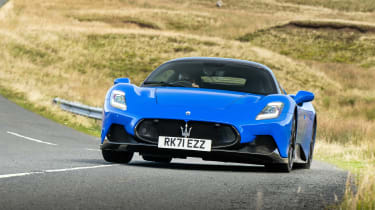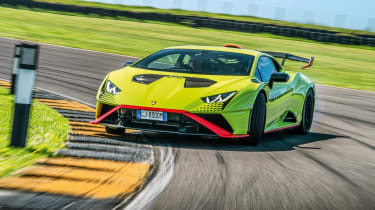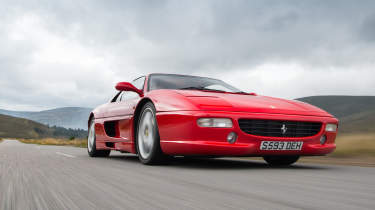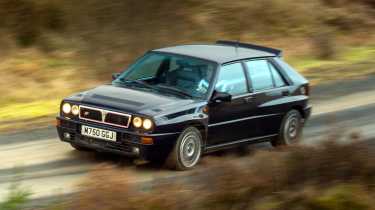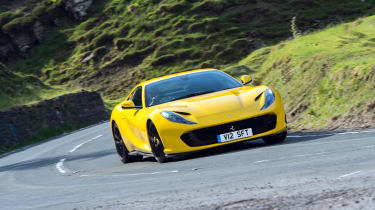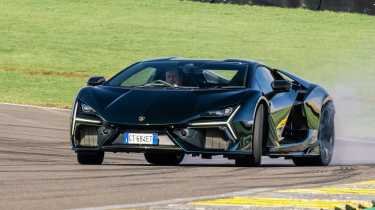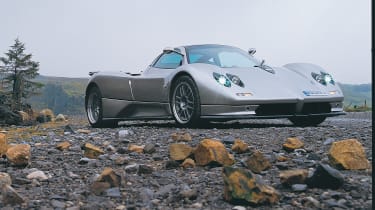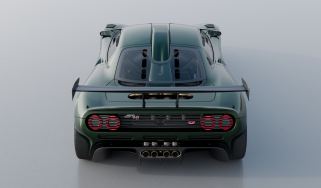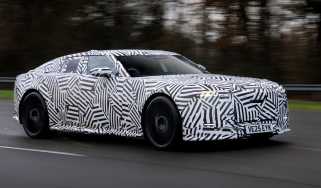Best Italian cars – Italy's finest driver's cars from Alfa to Zonda
It’s Italian cars that put journalists at the most risk of summoning nauseating hyperbole and time-worn cliches, for good reason. These are the best
Italy is undoubtedly the land of the supercar. From Ferrari to Lamborghini, Maserati and, latterly, Pagani, Italy does multi-cylindered exotics like Germany does Autobahn-slaying übersaloons. In only late April 2025 alone, the latest in a long line of astonishing super-focused mid-engined Ferrari supercars, the 296 Speciale, broke cover, as first drives of Alfa Romeo’s limited-run mid-engined coachbuild also hit the web and newsstands.
But to dismiss Italy as only making supercars, would be reductive. Over the years Italian manufacturers have taken on the very best hot hatches, supersaloons and grand tourers with their own entries, with the very best infused with the same intangible X-factor that flows so freely through the crags of supercar valley.
Below, then, is a selection of the very best Italy has had to offer, spanning its entire output, from unobtainable hypercars to punchy hot hatches, all of which we at evo have driven and tested extensively. Quite the high bar for the new Ferrari 296 Speciale and Lamborghini Temerario to clear…
Ferrari F80
Ferrari doesn’t tend to drop the ball with its top-flight hypercars, and despite a move to turbocharged V6 hybrid power from the LaFerrari’s hybrid-assisted V12, the F80 still feels incredibly special – and even more capable. The V6 move makes sense both from a marketing perspective and a mechanical one too – the V6 sits nicely with the brand’s Le Mans and F1 programmes, and it literally sits nicely, low and far back in the car’s carbonfibre chassis for optimal weight distribution.
> Ferrari F80 2025 review – hybrid V6 hypercar is a worthy successor to the LaFerrari
On its own the turbo V6 makes 888bhp, and when electric power is factored in, this is an 1183bhp car. E-turbos virtually eliminate lag (and electric torque fill helps there too, with a pair of motors up front for extra power and traction), while the wide-angle V6 still sounds great. Acceleration is a real slam in the back but it’s no low-rev slugger; the limiter is set at 9200rpm. On track, it’ll meter out hybrid power like a racing car, for either consistent lapping or a single banzai qualifying lap, but it’s an engaging road car too, which is probably even more impressive.
Ferrari 296 GTS
Was Ferrari’s decision to swap its turbocharged V8 for a turbo V6 with hybrid assistance a bad move? Not a bit of it. If anything, the 296 GTB sounds better than those old turbocharged V8s (if not the naturally-aspirated ones that came before), as well as lifting performance to a whole new plane thanks to the 819bhp output of V6 and electric motor. The smaller engine is also 30kg lighter, centralises mass a little better, and sits lower than the V8s too – so there are dynamic benefits for the taking.
> Ferrari 296 GTS 2025 review – V6 berlinetta goes roofless to fight the McLaren 750S Spider
In most respects, the 296 follows a familiar path for these mid-engined Ferraris, with incremental improvements in every area even if you ignore the new drivetrain. The chassis is more biddable than ever and the electronics helping you manage all that power are more sophisticated – Ferrari has mastered the art of reining you in while making you feel like a hero, though even if you turn everything off, the car’s natural poise makes it amazingly approachable. The usual fast Ferrari steering rack even offers some feedback too. In all, the 296 makes you wonder why you’d spend the extra for an SF90.
Ferrari 812 Competizione
The idea that the 812 Superfast could somehow be made more exciting seems absurd, but that’s effectively the role that Ferrari filled with the 812 Competizione. With stronger components and less internal friction, Ferrari managed to extract a further 30bhp from the 6.5-litre V12, raising its output to 819bhp, and the rev limit to 9500rpm. The dual-clutch gearbox was also revised, and there was a suitably vocal exhaust exiting through the rear diffuser. Then there were the aero changes, rear wheel steering in which each rear wheel could adjust independently, and wider front tyres for more grip.
> Ferrari 812 Competizione review – a front-engined V12 crescendo
And yes, the results were pretty special. ‘The V12 simply revs and revs’ is how Adam Towler put it in 2021. ‘No one could ever call a 819bhp car friendly, but the Competizione doesn’t feel on a knife’s edge, instead encouraging you to use more and more of the engine’s exertions as your own confidence increases.’ At nearly half a million pounds, buyers paid handsomely for the privilege, but received a car that showed not all supercars have their engines behind the driver.
Ferrari F12tdf
With the Ferrari 599, the concept of the front-engined V12 Ferrari grand-tourer began to blur into a kind of front-engined supercar instead. The F12 took things further, but it was the F12tdf, for “Tour de France”, where things got really serious. The tdf was to the regular F12 as a Speciale was to the 458: lighter, sharper, faster, and more exciting than numbers in a brochure could ever convey. Reviewing the F12tdf in 2015, Jethro Bovingdon said it had ‘the glamour and inherent balance of a big front-engined rear drive machine, the breathless excitement of a normally aspirated V12 and so many cuts, slashes and aero devices that it reeks of motorsport and technology’.
> Ferrari F12tdf review - ferocious 769bhp V12
That tech included a 769bhp variant of Ferrari’s 6.3-litre V12 (up from 730bhp in the regular F12), 30 per cent faster upshifts from the dual-clutch gearbox, shorter ratios, 110kg of weight savings, wider tyres, four-wheel steering, brake calipers from the LaFerrari, more downforce… basically, no stone had been left unturned. On track it took no prisoners, and on the road it was far from fluid thanks to its hyperactive responses, but it was a challenge with real rewards.
Ferrari Enzo
Name your car after the founder (well, after his first name – obviously all Ferraris bear his surname…) and it has to be special. The Enzo was certainly that, even considering the bloodline it had to follow: 288 GTO, F40, and F50. The Enzo continued the F50’s use of a V12 engine, albeit an all-new “F140” unit (still used today in the 12Cilindri) rather than its predecessor’s F1-derived Tipo F130, but brought in modern tech like an automated manual gearbox and predominantly underbody-focused downforce.
> Ferrari Enzo (2002 - 2004) – review, history and specs of an iconic hypercar
An F1-like experience was the goal – probably more compelling in 2002 when F1 cars still used V10s and star driver Schumacher was cleaning up, than it would be today with hybrid V6s and the Scuderia’s struggles… regardless, when we first drove the car, it was the power, the brakes, and the car’s agility that really impressed. It feels wide on UK roads, and needs precise inputs, but it’s as absorbing as a range-topping Ferrari should be.
Pagani Huayra
While cut from the same cloth, the Huayra was in many ways a very different car to the Zonda it followed. Primarily, in the way it was powered. Where the Zonda had used naturally-aspirated AMG V12 power and was initially at least available with a manual gearbox, the Huayra swapped that for a 6-litre twin-turbo AMG V12, and an automated manual. Given the Utopia has returned to a manual gearbox, perhaps the latter change didn’t sit well with all customers – but that’s not to say the Huayra wasn’t enormously exciting.
> Pagani Huayra review – did it step out from the Zonda's shadow?
It was certainly something to behold, with clear family resemblance to the Zonda but a curvier, even more exotic appearance. The same went for the cabin, and the details, and pretty much everything else. And it was great to drive, especially when the Huayra BC arrived with more power, more sophisticated aerodynamics, a new gearbox and a new e-diff. Driving the BC in 2016, Jethro Bovingdon described a car ‘more subtle than the brutal Koenigsegg but still with plenty of menace, and with a sense of occasion that puts the P1 or 918 Spyder in the shade.’
Ferrari 360 Challenge Stradale
There had been hardcore, road-going versions of Ferrari’s Challenge cars before, but the 360 Challenge Stradale was the first to see real volume production, and the first with a bit of 2000s-era polish; old 348 and 355 Challenge cars were more like road cars with a few racing parts strewn around the place. For the 360, you got lightweight buckets, carbon door cards, no carpets, and even optional Lexan windows; owners who ticked every box could save 110kg from a regular 360.
> Hardcore Ferrari V8 specials go head-to-head
The naturally-aspirated V8 meanwhile developed 26bhp more, for 420bhp from 3.6 litres. And a seriously loud exhaust, the sparsely-trimmed cabin doing little to dampen the noise coming from behind. Adam Towler described it as a ‘brutal, tearing howl’, yet the handling by contrast feels surprisingly approachable, in part thanks to the 360’s compact size and great visibility. ‘There’s a lightness of touch, too – in the steering, the way the car rides bumps, changes direction. It’s a nimbleness that helps it shrink around you, makes it less intimidating. And when the tail begins to slide, it does so progressively, communicating clearly’ is how he described it in 2018.
Ferrari 288 GTO
Purely as a work of art the Ferrari 288 GTO has to be considered one of the brand’s best cars. Like a 308 GTB, but with its proportions pumped-up and perfected, it’s truly stunning – but designed for Group B competition, it was also mechanically mighty and pretty spectacular to drive; indeed, the GTO held its own in one of evo’s greatest ever tests, when we compared it with the F40, F50, and Enzo in issue 064 in 2004.
> Great Ferrari hypercars driven: 288 GTO, F40, F50 and Enzo head-to-head
Compared to its successors, the GTO felt somewhat luxurious, trimmed like any other Ferrari of the era, but with 395bhp of turbocharged 2.9-litre V8 power behind you, it has around 150 more horses to play with. Steamroller rubber helped it hook up and when writing 2004’s test, John Barker found it ‘so poised, so balanced, so easy to drive very quickly indeed’, with feelsome steering and a ride quality that barely noticed the broken Welsh roads beneath its tyres. If you want any more evidence that it’s one of the greats, consider that it finished second to only the F50 in that test.
Ferrari F40
How many people still list the F40 as their dream Ferrari? We’d bet it still nudges out just about every other car that Maranello has ever made; it’s the poster car to end all poster cars. There’s the mythos of course – the fact it was the last car personally signed off by Enzo Ferrari before his death – but mostly it’s that uncompromising road-racer shape, brutal twin-turbo 2.9-litre V8, and of course, the way it drives (even if most of us will never get to experience it).
> Ferrari F40 – review, history, prices and specs
Those lucky enough to get behind the wheel (including several at evo) will tell you tales of steam-train thrust once the turbos are spinning, all kinds of growling and whooshing noises as it does so, but also the precision and communication of the steering and chassis, the grip it can generate, and the sheer excitement of managing it all when you’re only ever a throttle-flex away from lighting up the rear tyres. Best of all, you can probably imagine all that just from staring at the poster.
Alfa Romeo 8C Competizione
The introduction of the 33 Stradale into the modern Alfa lineup doesn’t sound too strange – after all, it’s being sold alongside the fantastic Giulia and Stelvio Quadrifoglio and their similarly talented rangemates. When the 8C Competizione arrived in 2007 though the Alfa range was a motley assortment, from the likeable but ageing 147 and GT, to the stylish but hardly class-leading 159 and the overweight Brera. And yet, Alfa fans still went nuts for it, and the brand managed to sell every one it planned to make in just two weeks.
Did the drive live up to the hype? Almost – tangentially related to the Maserati GranTurismo, it featured a 4.7-litre, 450bhp V8, rear-wheel drive, and a six-speed paddleshift transaxle, as well as double wishbones all round and carbonfibre body panels that made it 300kg lighter than the Maser. While a little softer than we were expecting, the 8C nevertheless had great balance and an absolutely fabulous engine, all wrapped up in a shape that made (and still makes) most people go weak at the knees.
Lamborghini Huracán Tecnica
Little by little, Lamborghini made the Huracán great. It started out pretty good, of course, all the way back in 2013. But by the time Huracán production ended we’d been able to enjoy models like the Evo RWD, STO, Sterrato, and the Tecnica, all of which were genuinely spectacular supercars.
> Lamborghini Huracán Tecnica review – a supercar of the old-school
The Tecnica probably best represents the model, sitting between the talented Evo and the gloriously manic STO, and is the one we’ll be thinking of when wondering whether the Temerario is really an improvement. It certainly can’t top the Tecnica’s V10 for theatre, while the Technica’s STO-inspired upgrades give it a dose of aggression above and beyond that of the Evo, feeling at home both on road and track, yet also being surprisingly approachable for a car with 631bhp - a sign of how hard Lambo’s engineers worked to refine the Huracán’s handling over the years. As Dickie Meaden put it after driving the Tecnica, ‘the Huracán has never burned brighter’.
Lamborghini Gallardo
Lamborghini had been dangling the prospect of a V10-powered entry-level model in front of us for well over a decade before the Gallardo arrived – and it didn’t disappoint. Like the larger Murciélago it needed the deeper pockets of Audi in order to happen, but also like its V12 counterpart, Germanic influence was found predominantly in the car’s quality rather than the way it looked and drove – exactly how you’d want it.
> Lamborghini Gallardo (2003 - 2013) review – the baby V10 supercar that saved the company
Early cars used a 5-litre V10 making a nice, even 500bhp, comfortably trouncing the Ferrari 360 that had debuted a few years earlier, and the chiselled shape was compellingly compact – at 4300mm, shorter than the 4432mm Porsche 996. It didn’t get its big brother’s scissor doors, but that theatre aside there wasn’t much to complain about. It’s a friendlier car to get used to than the Murciélago, has neutral handling, and a surprisingly supple ride, but with measured hydraulically-assisted steering and the available manual gearbox, already feels a generation or two removed (in a good way) from today’s supercars.
Lamborghini Murciélago
If any of us were worried that Audi’s ownership of Lamborghini would lead to the brand’s cars being toned down, the Murciélago was a big, V12-powered, brazenly-styled and usually-orange response to our fears. The first all-new Lambo to arrive following evo’s founding, and one that has become very familiar in its pages thanks to Simon George’s now more than 300,000-mile example, it is undoubtedly one of the great Lamborghini supercars.
> Lamborghini Murciélago (2001 - 2011) review – an unadulterated supercar icon
Audi’s involvement certainly led to a step up in quality but Luc Donckerwolke’s styling was as in-your-face as a Lamborghini should be – and is ageing fabulously – while the 6.2-litre version of the famous Bizzarrini V12 produced a glorious noise and delivered a killer punch at 570bhp, through all four wheels. Through today’s lens it still feels surprisingly old-school, and its size remains intimidating, but it was undoubtedly a step on from the Diablo at the time, and as George’s car has proven, albeit with some big bills along the way, it really was built to last too.
Lamborghini Gallardo LP560-4
The Gallardo was good, but the LP560-4 showed it could get even better. 2008’s update came with a more aggressive look that previewed the direction the brand’s styling was heading (later revealed by the Huracán and Aventador), but also a new engine. This 5.2-litre unit was surprisingly different from its 5-litre predecessor, with a new firing order, direct injection, and a higher compression ratio, making it both cleaner and more powerful, at 552bhp.
It’s an engine we’ve since become very familiar with from later Lamborghinis and Audi R8s, and while in retrospect we’re more fond of the early engine’s character, the 5.2 was hardly short on sparkle. Ditto the handling, which Lamborghini refined for the LP560-4, and continued refining until the car was replaced by the Huracán. Testing the car in 2008, John Simister called it ‘deliciously steerable on the throttle’ in the new Corsa driving mode, which also called up quicker gearshifts from the latest e-gear automated manual transmission.
Alfa Romeo Giulia GTAm
As you’ll have read above, the Alfa Romeo Giulia Quadrifoglio is already an evo favourite. What better platform, then, to create something even more focused? That’s the role the GTAm served when it arrived in 2021; think of it a little like a BMW M3 CS to the regular M3, or Jaguar’s Project 8 to an XE. Designed as a 110th birthday gift to itself, the GTAm was wider, featured dramatic aero, and was lighter too, thanks to polycarbonate glazing and the binning of the rear seat bench.
> Alfa Romeo Giulia GTAm (2021 - 2022) review: if Porsche built a four-door 911 GT3 RS
Just as a Megane R26.R was surprisingly liveable despite its racy additions however, so too was the GTAm relatively uncompromised by its changes. It felt even more special than the Quadrifoglio but was no more difficult to drive, and a button to soften off the dampers meant it even retained the Quad’s pliant on-road ride. Dickie Meaden summed it up as a ‘polished’ experience, where everything felt ‘just right’ and had ‘true depth of dynamic quality’. Only the hard-to-read electronic limited-slip diff came in for any real criticism.
Alfaholics GTA-R
Italy by way of Somerset, this one, and one of the most perfect driving machines on this page. The Banks family have been restoring Alfa Romeos for more than 40 years, but for more than 20 of those years Alfaholics has been building and developing the GTA-R – a classic 105-series Alfa Giulia GT, inspired by the old GTA road and race cars, honed to the nth degree with modern parts and expertise.
More recently, that development has included full carbon body shells and more, but the bare bones simply build upon a classic that was already great to drive. It’s how restomods should be done, really – less tinsel, and more effort weeding out the typical old-car weaknesses and enhancing the best bits. A good drive in a GTA-R will make you question why you’d even bother with a modern supercar.
Ferrari 458
We’ve already included the 458 Speciale, for obvious reasons, but the reason the Speciale was so good is because the 458 itself was, and remains, something of a high-point in the mid-engined Ferrari sports car story. It’s a sort of best-of, combining all Ferrari’s contemporary technology for a spectacular driving experience, in a shape that to this day might be the prettiest in its long lineage.
> Ferrari 458 (2009-2015): review, specs and buying guide
The biggest step over the 430 it replaced was in ditching the automated manual “F1” gearbox (and a gated six-speed manual, but few bought those) for a dual-clutch automatic. Gearshifts were now both lightning fast and imperceptibly smooth, and perfect for making full use of the 4.5-litre V8’s searing 9000rpm red line and its 562bhp output. Hyper-responsive steering and a beautifully-balanced chassis made the power easy to exploit too, especially as Ferrari was really getting a handle on driver-assisting electronics. Less excitingly, but no less impressively, it was also a big step up in quality – 458s really seem to last, making them just as appealing today as they were back in 2009.
Ferrari 488 Pista
Following up the 458 Speciale was no small task, given it was one of Ferrari’s greatest ever driver’s cars. But Maranello gave it a jolly good go with the 488 Pista, aided by the monstrous 711bhp afforded by the 488’s turbocharged engine; if nothing else, the new car would be more brutally accelerative than its predecessor, and even before its tweaks, the turbocharged engine was virtually lag-free.
Like the Speciale, it was an experience even being in and around the Pista – four-point harnesses can be a pain to use, but they don’t half ramp up the excitement once you’re strapped in. A firm-feeling ride played to the racing-car feel, but unsurprisingly, it just works on the road. As did Ferrari’s ever-improving electronics, which let you deploy all that thrust both in a straight line, and around corners, in a way that boggles the mind. The brakes are enormously powerful and easy to modulate, and the steering lightning fast but predictable – it really is possible to get into a flow on a country road in a Pista, despite its extreme appearance suggesting it’s better reserved for track use.
Alfa Romeo 33 Stradale
The latest in a long and illustrious line of Italian supercars but, being an Alfa Romeo, in a family of one. Does the 8C count? Being as lusty as a supercar doth not a supercar make. No, arguably Alfa Romeo’s only prior proper supercar was the original 33 Stradale of the 1960s, and it is to this which this new car, hewn in its image, pays tribute. Using the carbon bones and V6 engine of the Maserati MC20 as its basis, the 33 Stradale is clothed in custom carbon coachwork, with a fully bespoke cabin.
> Alfa Romeo 33 Stradale review
Here is a car that is a paradox. In distilling so richly the raw ingredients that make so many so passionate about Alfa Romeo, the Milanese marque has created a car inaccessible to most. But it is as an Alfa Romeo should be: a rolling artwork, a coachwork as stimulating to behold as it is to drive.
Ferrari 458 Speciale
There is perhaps no other modern-era Ferrari as exciting as the 458 Speciale. It feels like a focal point for everything the company does well – incredible engines, beautifully balanced chassis, and stunning visuals – and is undoubtedly one of the most complete performance cars evo has ever tested.
Ferrari had shown moments of genius in the run up to the Speciale – the 360 Challenge Stradale and 430 Scuderia that had come before were intoxicating cars in their own right. But the standard 458 was such a complete package, bolstered by sophisticated electronics and one of the best dual-clutch transmissions on the market, that applying the road-racer formula was only ever going to result in something spectacular.
There’s an argument to be made that the car that followed, the 488 Pista, goes even further up each of those paths. But it lacks one crucial element that seals the Speciale package: that car’s screaming naturally aspirated V8. With 133bhp per litre and a 9000rpm red line, it’s simply one of the great production car engines.
The Ferrari 296 Speciale represents the first time Ferrari has revisited a name for one of its track-focused models. That it chose this one either speaks to their confidence, or foolishness. There is no mightier Ferrari for it to live up to.
Alfa Romeo Giulia Quadrifoglio
Cars like the BMW M3 and Mercedes-AMG C63 have never been more powerful, more capable or easier to use every day – yet the Alfa Romeo Giulia Quadrifoglio introduced in 2016 still had the measure of them in almost every way that counted, and remains right at the top of its game, even at the end of its tenure in 2025.
Even the most ardent Alfa Romeo fans would admit the company’s products have been hit and miss over the years, and the Giulia itself has had a few quality niggles from the outset, but there probably hasn’t been an Alfa quite so competitive since the 1960s. Even in standard 2-litre petrol form it drives well, floating over poor surfaces, turning into corners with agility and powering out of them with balance, but the Quadrifoglio really is special.
> Alfa Romeo Giulia Quadrifoglio review
Few cars with this much power (503bhp) make it feel so usable, in the dry at least (its sticky Pirellis don’t hold on quite so well on damp roads), letting you meter its output with precision. Never has that been more so the case than with the updated, 513bhp car, with its locking limited-slip differential. The ride quality is excellent, the touchpoints wonderful – short of Ferrari, nobody does gearshift paddles this well – and to most eyes it looks rather good too. Even Alfa’s Stelvio SUV, built on the same platform, is pretty damn capable…
Maserati MC20
It’s quite astonishing really that Maserati produced the MC20, as excellent a car as it is, with little to no run-up. It has no predecessor, unless you count the incredibly tenuous link back to Maserati’s last mid-engined supercar, the Enzo-based MC12. Maserati doesn’t even have sports cars in its recent past, the GranTurismo always on the softer side of the grand tourer genre, sharing forecourt space with saloons and SUVs.
By rights then, the MC20 should have been a duffer, to be improved upon throughout its life, until the last run-out model maybe finally got it right, as has been the case with so many others. Not the case. It sprung out of Modena on no less than evo Car of the Year-winning form, bewitching our testers with its balance, feel, performance and personality. It cleared the win ahead of some historically stiff competition too, beating everything from the McLaren Artura and Ferrari 296 GTB, to the Audi R8 RWD Performance and Porsche Cayman GT4 RS.
Its constituent parts wouldn’t have you imagining an Alpine A110-like driving experience – a 621bhp twin-turbo V6 with a rabid bark and a hunger for revs, a carbon chassis, variable drive modes (with independent controls for the damping) – but that’s what it offers. This 203mph, slightly dumpy (somehow it weighs almost 1500kg) supercar dances and rewards like a lithe sports car.
Ferrari LaFerrari
Perhaps the greatest irony of the ‘holy trinity’ era is that, for all the top trumping and comparing of the three cars in question by those who didn’t have a hope of making one their own, people actually in the market for cars like the LaFerrari, Porsche 918 Spyder and McLaren P1 usually just had one of each.
But now as then, one did seem to stand out from the other two, combined the most emotive powertrain with astonishing performance, real drivability and exploitability, unrivalled heritage and, as we’ve come to note over the last decade, unbeatable residuals… Yes, the LaFerrari is the only of the three to have tripled in price since its introduction. Why is that? There’s no arguing with the kudos of an all-out Ferrari flagship, though the controversial F80 may yet prove that statement wrong.
The LaFerrari, however, for all its hybrid tech and in-house, Pininfarina-shunning design, is about as ‘Ferrari’ as Ferraris get. That V12, a powertrain offering over 900bhp in total, a carbon tub, absolutely jaw-dropping presence and, utterly unexpectedly, an approachability and drivability that renders it putty in your hands. Whisper it, but Ferrari flagships before the LaFerrari had their flaws.
The Enzo was a numb steer and had a slightly shonky gearbox. The F50 was harsh and without the blistering performance of its direct rivals, and the F40 was a little rough around the edges – literally, just look at the glue. The driving position was very ‘of its time’ too. Though we love all these cars despite their flaws, the LaFerrari is distinct from them for essentially being without any. Owners who have had to deal with the battery niggles might say otherwise, mind.
Lamborghini Huracán STO
Quite in opposite fashion to the Maserati MC20 also included elsewhere in this roundup of Italian greats, the Huracán took its time to come on song. On release, the original was numb, understeery and not the riposte Lamborghini needed to the excellent Ferrari 458 and McLaren 650S, even with that scintillating 5.2-litre V10. The first sign of life was the ‘RWD’ variant, then the Performante really proved what the Huracán was capable of. Then the Evo took it to the next level, further improved by the Evo RWD. And then came the STO. Once you learn the meaning of that acronym – Super Trofeo Omologato – and just look at the thing, you realise just how serious Lamborghini took its Huracán send-off.
> Lamborghini Huracán STO review
But to dismiss the STO as a racetrack refugee unsuited to road duties would be presumptuous. For the suspension has more ability to breathe with the road than you’d ever imagine for a car that looks like it just escaped the pitlane for the Daytona 24 Hours. Likewise, its direction control on a writhing, inconsistent road is good. Save for the road noise and the slightly torturous bucket seats, it’s perfectly amenable and actually a joy to exploit on the road. Truly great hardcore cars don’t feel caged and muzzled when confined to the public road and that’s exactly what the STO manages, to an eCoty podium-sitting standard. What a crescendo for Lamborghini’s sophomore junior supercar, even if the Technica was the actual last Huracán.
Ferrari F355
It might have looked superficially similar to the Ferrari 348 on the outside, but the F355 that debuted in 1994 was quite different under the skin. It turned the pretty but often derided 348 into one of the best sports cars of the 1990s in one fell swoop.
The F355 received a facelift inside and out, with a higher-quality cabin and curvier, more ’90s-friendly lines externally, but the most significant changes were in the engine bay and the chassis. The former received a displacement increase and a new five-valve head, while the latter received active dampers and improved underbody aero.
In concert, it resulted in a more powerful engine (while the open-gate manual gearshift was improved to be a little more usable when cold and a little more positive the rest of the time), but also a taming of some of the 348’s on-limit handling characteristics. To this day, the 355’s low-slung lines and buttressed engine cover still look rather fine, too.
Lancia Delta Integrale
No Abarth, nor any Fiat or Alfa Romeo, can top the Lancia Delta Integrale as a relatively ‘normal’ entry so indelibly etched in Italian performance car lore, alongside exotica ad infinitum. This humble hot hatchback was the stuff of bedroom-wall posters in the 1990s, alongside Lamborghini Diablos and Ferrari F40s. No doubt it owes much of its acclaim to its place as a hero of Group A rallying history, wearing the almost inimitably memorable Martini livery from which Lancia’s motorsport history is so inseparable.
> Lancia Delta Integrale review
But the joy of the Delta Integrale is that it’s a hero you definitely want to meet. Get past the shall-we-say quaint driving position, warm through that effervescent, warbling four-cylinder turbocharged engine, learn to work the chassis and that AWD system and you have a gem on your hands.
Ferrari 812 Superfast
Like the 458 Speciale, the Superfast has a super-broad range of talents that would make it a wonderful car even with a distinctly average engine under its long bonnet, but it is elevated to new heights by its actual powerplant, a 6.5-litre, 789bhp, naturally aspirated V12.
That engine is a work of art – whether you use it to power a car, sing a symphony or just bolt it to a plinth and stare at it. Derived from the engine first introduced in the Enzo, it’s a perfect example of why it’s difficult to see electric motors ever matching combustion power for emotive value; all the two-point-something 0-60s in the world count for nought against the thrill of extending the 812 to its 8500rpm power peak.
> Ferrari 812 Superfast review
The 812’s styling is an acquired taste even though the car is undoubtedly a dramatic thing to behold. The cabin, and the way the V12 settles down at a cruise, make the Superfast a genuine grand tourer too. Its ability to cover distance in comfort and then wow you with its abilities at your destination, it’s a mighty combination – one its softer-edged successor, the 12 Cilindri, has struggled to live up to.
Lamborghini Revuelto
Not in the history of flagship Lamborghini V12s has there been one without its flaws. All have been utterly overflowing with character and energy but all have, conversely, been compromised in some way, to varying degrees. From the fire-prone Miura, whose nose would go light at speed when low on fuel, to the Aventador with its jerky gearbox and somewhat leaden feel.
The Revuelto, though, combines the outlandish looks and incredible V12 engine that are flagship Lambo staples with crazy hybrid powertrain tech, rear-steering and adaptive drive mode systems to create a boss Bull without compromise. It adds agility and exploitability to the long-standing Lambo toolkit of drama, flamboyance and, in this case, far more performance than ever before – over 1000bhp, since you’re asking. You don’t even need to wake your neighbours anymore, thanks to its useful (if limited) electric-only range.
Pagani Zonda
What defines a supercar? High performance has to be a factor, as does truly eye-catching styling. It should ideally be both capable and thrilling to drive in equal measure, have a degree of exclusivity, and feel crafted by people who care about every single detail – because when you’re spending supercar money you expect a genuinely super car.
The Pagani Zonda could be used to represent the supercar in a dictionary. Even the earliest C12, more than 20 years old now and developing by today’s standards a modest 395bhp from its Mercedes-sourced V12, fits the bill, but styling got progressively wilder and the V12s more powerful as the years went on.
It was no mere styling exercise either – Zondas have always been great to drive, and with fewer than 200 examples produced to date, it’s certainly exclusive. And crafted by people who care about every single detail? You’ll find few in this industry more passionate about their product than company founder Horacio Pagani.
‘The passage of two decades can be cruel to once cutting-edge supercars, but the naturally aspirated Zonda, complete with six-speed stick-shift gearbox, feels timeless and epic. It moves with elasticity, that big, free-spinning Benz V12 simmering with seismic potency. It is majestic, as only large-capacity 12-cylinder motors can be.
